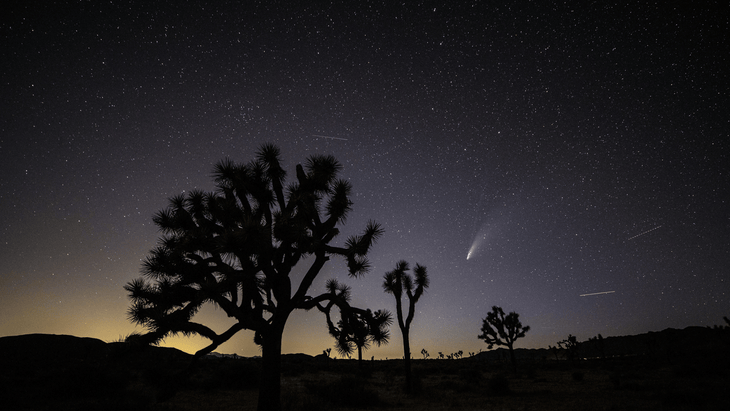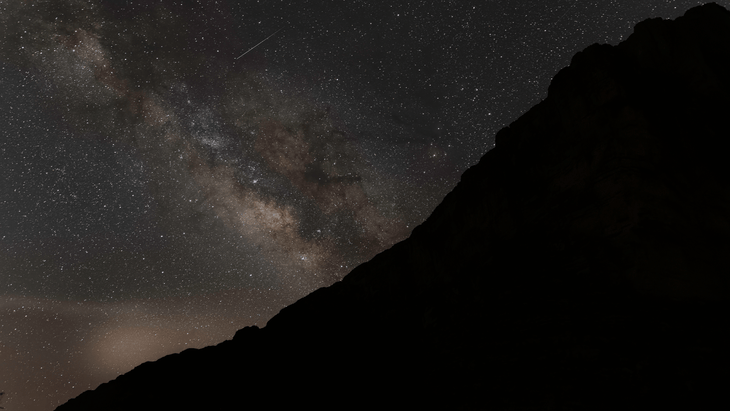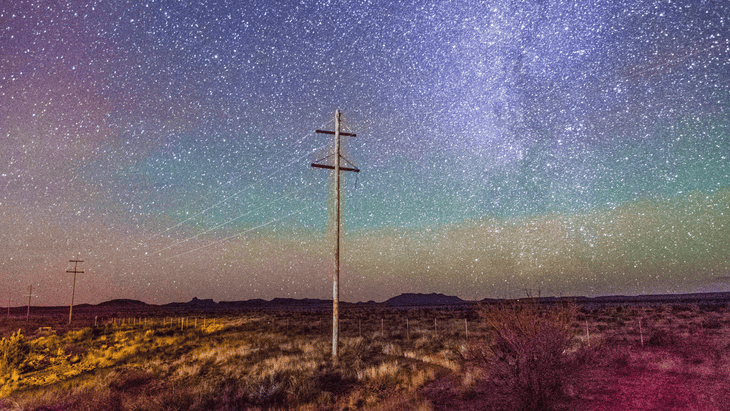New perk: Easily find new routes and hidden gems, upcoming running events, and more near you. Your weekly Local Running Newsletter has everything you need to lace up! Subscribe today.
Sunlight is so 2024.
Ditching daylight for nocturnal adventures is skyrocketing in popularity. And night running is not immune. From starbathing to constellation tracking, the inclination for nighttime experiences is blooming in the U.S. and around the world.
In 2024, record-breaking displays of the northern lights colored skies in vibrant hues around the globe, prompting bucket-list trips for aurora hunters pining to see the ethereal phenomenon. Likewise, when the total solar eclipse crossed North America last April, millions of skywatchers hustled to observe the mesmerizing event.
As the obsession with cosmic matters and the night sky continues to grow, so does the rise of an unconventional type of tourism. Travel will no doubt be reimagined in 2025, according to research from Booking.com, one of the leading digital travel companies. In its global survey of more than 27,000 travelers, the site reported that nighttime travel experiences, like astro and noctourism, are projected to be among the most popular getaways this year.
And fortunately, there’s plenty to see—including from on the move on two feet. We’ve rounded up some notable starry events and after-dark happenings in the U.S. that you can also experience actively. From night hikes to trail runs at dawn, to decamping in your backyard, mark your calendar for these spellbinding celestial phenomena worth your while.
Total Lunar Eclipse: March 14
On the night of March 13 and into the early morning of the 14th, the moon will pass through the Earth’s shadow. As it’s filtered by sunlight, the result is a red-orange hue often described as a “blood moon.”
This celestial event, known as a Total Lunar Eclipse, will last for 6 hours and 3 minutes, according to Space.com, the premier source of space exploration, innovation, and astronomy news, and it will be visible across all of the continental U.S., almost all of North America, and the western half of South America.
So if you live in the U.S., you don’t have to go far to enjoy the view. Simply step outside and peer up at the sky. Or better yet, hike or do some running at night up a nearby hill for an unimpeded view and sense of adventure. NASA advises that a Total Lunar Eclipse is safe to look at directly with your eyes. While special glasses will not be needed, binoculars or a telescope can enhance the experience.
Lyrid Meteor Shower: April 15 to 30

Originating from comet C/1861 G1 Thatcher, the Lyrids are one of the oldest known meteor showers—space rocks passing through earth’s atmosphere result in sparkling fireballs—and among the biggest with up to 18 shooting stars per hour.
You’ll have a chance to observe what is considered one of the most radiant annual meteor showers in mid-April. Keep in mind that the shower will peak on April 21. For optimal viewing, it’s best to escape city and suburban lights, and, ideally, observe from a certified dark sky area. That is areas or sites that have been officially recognized for low levels of light pollution and are publicly accessible.
Joshua Tree National Park in Southern California is one of them, and with nine campgrounds, it’s opportune to pitch a tent as your base before heading to one of the park’s best trails for stargazing to catch a glimpse of the dazzling Lyrids.
Buck Moon: July 10
According to The Old Farmer’s Almanac, July’s full moon is nicknamed the Buck Moon in reference to male deer and signifies their antlers in full-growth mode. In Anza, California, this is an occasion to lace up your running shoes for the annual Elder Creek Night Runs. Though the race takes place two days after the Buck Moon, the moon will be 98 percent illuminated in its Waning Gibbous phase.
The race, which is capped at 200 participants, is held around a 4.6-mile loop with a mix of single-track trail and wide-open dirt road, and distances range from 9 miles to 50K on the Cahuilla Band of Indians reservation. Ultratrail runner Jessica Hashimoto, who participated in the 30K last July, described the experience as nothing short of electrifying.
“The phenomenon of a full moon and how it changes people’s energy is no secret to me,” Hashimoto said. “There’s something really special about running during a night like that. It causes one to realize just how small a human being is compared to the universe.”
Perseid Meteor Shower: July 17 to August 24

Swift-Tuttle, a large comet that orbits the sun every 133 years, was last officially observed in 1992. Its ice and rock debris, however, collide annually with the Earth’s atmosphere at high speeds, averaging 133,200 miles per hour, resulting in the Perseid Meteor Shower. Up to 100 meteors will streak the sky hourly from July 14 until mid-August in what is described as one of the most prolific displays of shooting stars.
The Perseid Meteor Shower is actually visible to the naked eye across the U.S., but the more remote and darker the sky, the better the view. Great Basin National Park, in eastern Nevada bordering Utah, is an International Dark Sky Park that offers a premier and unobstructed showing, as does the Great Sand Dunes National Park in Colorado, home to the tallest sand dunes in the U.S.
Or consider a trip to Big Bend National Park. When you’re as remote as Brewster County, in southwest Texas, it’s no wonder the night skies are described as dark as coal. This is home to unspoiled wilderness stretching 801,163 acres over protected land that is also considered one of the country’s best destinations for stargazing.
It’s an occasion to lay on your back and enter a state of mindfulness, before peering at the (hopefully) cloud-free sky. The Planetary Society—a non-governmental organization that promotes space exploration, science, and technology—recommends allowing your eyes to adjust for a few minutes before looking at the darkest area of the sky.
Marfa Lights: Year-round

Just off of Highway 90, roughly nine miles east of Marfa—a small town in the Big Bend region of West Texas known for its contemporary art scene—pulsating colorful orbs can be observed at Mitchell Flat, reportedly for up to 40 minutes.
A young cowboy named Robert Reed Ellison, who was in the midst of tending cattle when he encountered the mysterious flashes, first offered an eyewitness account in 1883. Ellison reasoned the lights could have been Apache Indian campfires. Ever since, a string of theories have been devised about the phenomenon known as the Marfa Lights—ranging from the supernatural to what Apache Indians reportedly believed were stars dropping to earth.
Currently, there is no verified scientific explanation. But in his book “Strange Lights in West Texas,” James Bunnell—a retired Apollo-era NASA engineer, who studied the Marfa Lights for more than a decade—surmises the bright spheres are the result of ball lightning, a rare and unexplained natural phenomenon that appears as a glowing orb of electricity.
Head nine miles east of Marfa on Highway 67 to the well-marked roadside platform to catch a glimpse of the mystery lights, which reportedly appear just after sunset or sunrise. A nearby looped trail that’s a bit less than a half-mile offers an opportunity to stargaze as you wait in suspense.